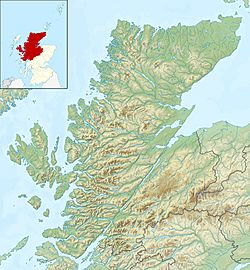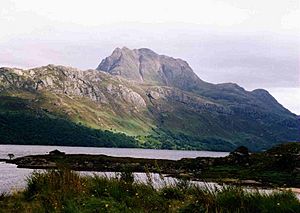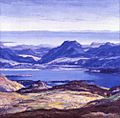Loch Maree facts for kids
Quick facts for kids Loch Maree |
|
|---|---|
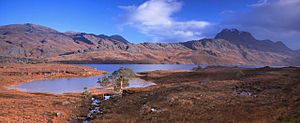
Panorama of Loch Maree, with Slioch in the background.
|
|
| Location | Northwest Highlands, Scotland |
| Coordinates | 57°41′23″N 5°27′27″W / 57.68972°N 5.45750°W |
| Catchment area | Beinn Eighe, Slioch, Fisherfield, Glen Docherty, Coulin, Slattadale, Talladale |
| Basin countries | United Kingdom |
| Max. length | 21.66 km (13.46 mi) |
| Max. width | 4 km (2.5 mi) |
| Surface area | 28.7 km2 (11.08 sq mi) |
| Average depth | 38 m (125 ft) |
| Max. depth | 112 m (367 ft) |
| Water volume | 1.09 km3 (38.5×109 cu ft) |
| Islands | 60 |
| Designated: | 19 September 1994 |
| Reference #: | 700 |
Loch Maree (which is Loch Ma-ruibhe in Scottish Gaelic) is a beautiful loch (the Scottish word for lake) located in Wester Ross in the Northwest Highlands of Scotland. It is about 21.7 km (13.46 mi) long and up to 4 km (2.5 mi) wide. This makes it the fourth largest freshwater loch in Scotland. It is also the biggest loch north of Loch Ness. Its total surface area is 28.7 km2 (11.08 sq mi).
Loch Maree is home to many islands, with five large ones that are covered in trees and over 60 smaller ones. Many of these smaller islands even have their own tiny lochs! The biggest island, Eilean Sùbhainn, has a loch that contains another island. This is a very rare sight in Great Britain.
One special island, Isle Maree, has the remains of an old chapel. People believe it was a quiet place for Saint Máel Ruba in the 8th century. He was a monk who started a monastery in Applecross in 672. Loch Maree is named after him. Before he arrived, people think the loch was called Loch Ewe. This is why the village at the eastern end of the loch is called Kinlochewe, which means "Head of Loch Ewe" in Scottish Gaelic.
This loch is very important for wildlife. It is one of the main places in Great Britain where black-throated divers come to breed. It also has a large number of otters. The islands of Loch Maree have some of the best natural Caledonian pinewoods in Scotland. These areas are also famous for their many types of dragonflies, with 12 different species found here. The waters, islands, and shores of Loch Maree are protected by several special conservation rules.
Contents
Exploring the Geography of Loch Maree
Loch Maree is much longer than it is wide. It stretches from the northwest to the southeast. The water flows out through a short river called the River Ewe. This river then goes into the sea loch of Loch Ewe, near the village of Poolewe. At the other end of Loch Maree, to the southeast, is the village of Kinlochewe. The A832 road runs along most of the southwestern side of the loch, connecting Poolewe and Kinlochewe.
Loch Maree is divided into three main parts, or basins. It has more islands compared to its water area than any other large loch in Scotland. The deepest part is called the Grudie Basin, which is about 112 m (367 ft) deep. It lies between Isle Maree and the end of the loch. To the northwest of this deep part is the Slattadale Basin, where most of the islands are found. North of the islands is a shallower area, which separates the Slattadale Basin from the Ardlair Basin. The Ardlair Basin has a more unusual shape.
The most famous mountain near Loch Maree is Slioch. It is one of Scotland's Munros, which means it is over 3,000 ft (910 m) high. Slioch stands tall over the eastern end of the loch, near Kinlochewe. It is a popular place for hill walking and climbing. Other mountains nearby include Beinn Àirigh Charr and Beinn Làir. The entire northeastern shore of Loch Maree is part of a large area called the Letterewe, Heights of Kinlochewe & Tournaig Estate. This area extends north into the Fisherfield Forest. The southwestern side of Loch Maree is also mountainous, with peaks like Beinn Eighe.
A Look at Loch Maree's History
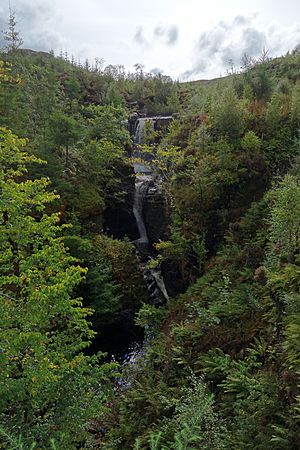
Around the years 671 to 722, Saint Máel Ruba came to Loch Maree. He built a small chapel on Isle Maree. Even though the chapel is gone now, the burial ground linked to it can still be seen. There's also a small well on the island that people say was blessed by the saint.
In the Middle Ages, the island of Eilean Ghrùididh in Loch Maree was an important place for the MacBeaths family. Later, around 1430, the Clan MacLeod took over. In 1965, experts found a fortified area on the island with thick walls and a deep dungeon.
Today, there isn't much industry around Loch Maree because it's quite remote. However, a long time ago, it was a busy place for making iron. In the 1600s, people used to cut down many oak trees every day to make charcoal. This charcoal was used to melt bog iron at Letterewe, on the northeast shore. Workers from these iron furnaces are believed to have been buried on Isle Maree. You can still see parts of an old iron furnace at a place called the Red Smiddy, near where the River Ewe flows out of the loch.
Loch Maree became a popular spot for trout fishing after Queen Victoria visited the Loch Maree Hotel in Talladale in 1877. Her visit led to a beautiful waterfall nearby being named Victoria Falls. In 1893, there was a plan to build a railway along the south shore of Loch Maree. This railway would have brought more tourists and helped with fishing and mail services. However, the plan was never carried out.
Amazing Wildlife and Nature
Loch Maree is incredibly important for its special wildlife and different kinds of plants and animals. It is one of the biggest breeding grounds for black-throated divers in Great Britain.
Sea trout and salmon are a key part of the loch's natural system. They provide food for black-throated divers and otters (Lutra lutra). Young trout are an important food source for the divers. Not long ago, thousands of adult sea trout (which are brown trout that go to sea) and salmon (Salmo salar) would return to the loch from the sea each summer. The sea trout would gather in huge numbers in certain bays. This made Loch Maree famous for fishing in Scotland. A record-breaking sea trout weighing 19.5 lb (8.8 kg) was caught here in 1952. However, the sea trout fishing greatly reduced in the 1980s and 1990s. The loch also has two different groups of Arctic charr (Salvelinus alpinus), but not much is known about them.
The islands of Loch Maree are covered in trees, and they have some of the best natural Caledonian pinewoods in Scotland. These forests are special because their trees are genetically different from other pinewoods in Scotland. They are more similar to those found in southern Europe. Scientists think this is because western Scotland was the first area to melt after the last ice age. This allowed pine trees to spread north along the western coast of Europe. Scots pine trees are the main type of tree in these forests. Other trees like rock whitebeam and juniper are also found here.
The islands of Loch Maree are especially known for their dragonflies. Twelve different types have been seen, including the northern emerald, azure hawker, and white-faced darter. You might also find Pine martens and white-tailed sea eagles on the islands. These islands are also a place where redwings breed.
Protecting Loch Maree's Nature
| Loch Maree Islands National Nature Reserve | |
|---|---|
|
IUCN Category IV (Habitat/Species Management Area)
|
|
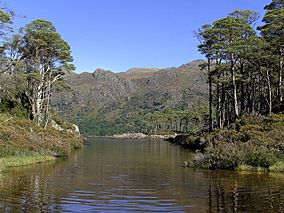
Amongst the islands of Loch Maree.
|
|
| Location | Wester Ross, Scotland |
| Area | 200 ha |
| Established | 1977 |
| Governing body | NatureScot |
| Beinn Eighe and Loch Maree Islands National Nature Reserve | |
Because black-throated divers live on Loch Maree, it has been given a special protection status called a Special Protection Area (SPA). The loch is also a Special Area of Conservation (SAC). This larger area, called the Loch Maree Complex SAC, includes the surrounding hills like Beinn Eighe.
More than 60 islands within the loch are part of the Loch Maree Islands National Nature Reserve (NNR). Since 2014, this reserve has been managed together with the nearby Beinn Eighe NNR as one big reserve. The Beinn Eighe and Loch Maree Islands NNR is also part of the main area of the Wester Ross UNESCO Biosphere reserve.
Loch Maree is recognized as a Category IV protected area by the International Union for the Conservation of Nature. It has also been named a Ramsar site since September 19, 1994. It is also a Site of Special Scientific Interest (SSSI) and is located within the Wester Ross national scenic area.
Loch Maree in Songs and Shows
A musician named Fergie MacDonald had a popular Scottish song in 1966 called "Loch Maree Islands." This song celebrates the beautiful views of the loch. Many other singers, like Calum Kennedy, have also recorded versions of this song. More recently, the band Peat and Diesel included a version of the song on their 2019 album Uptown Fank.
In 2009-2010, the BBC TV show Natural World featured Loch Maree. Episode 6, called Highland Haven, spent a whole year looking at the environment and wildlife around Loch Maree.
Loch Maree is also mentioned in the song "The Summer Walkers" by the band Runrig, from their album The Stamping Ground.
- And it's up by the Shin
- And up by the 'Naver
- And the long winding shores Of Loch Maree
- By Ben Hope and Ben Loyal
- Stack and by Arkle
- The road reaches far
- Now the summer is here
Folklore and Legends
Thomas Pennant, who wrote in 1772, said that people believed the waters of Loch Maree could cure madness. They thought that if someone was submerged in the water, it would help them.
Isle Maree has an oak wish tree that became famous after Queen Victoria visited it in 1877. She wrote about it in her published diaries. This tree, and others around it, are covered with coins that people have hammered into the bark. It is near the healing well of St. Máel Rubha, where people used to leave offerings. Some records say that even bulls were sacrificed there up until the 18th century. This makes some people think that the island was a place of ancient pagan worship before the saint arrived. The same island also has very old oak and holly trees that have been linked to ancient Scottish druids.
Just like Loch Ness, Loch Maree has its own monster! It is called the muc-sheilch.
Images for kids
-
Loch Maree by Sir David Young Cameron, c.1900-1924
See also
 In Spanish: Lago Maree para niños
In Spanish: Lago Maree para niños


